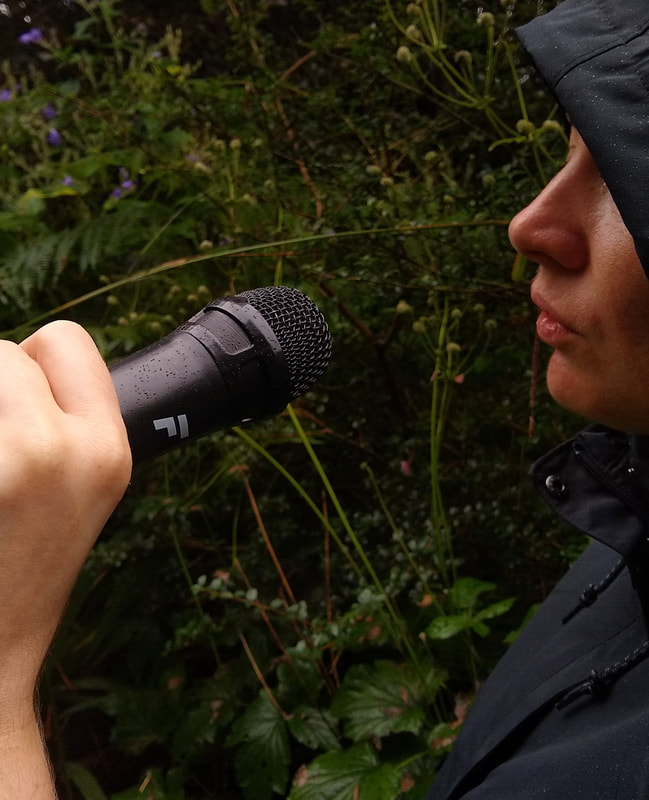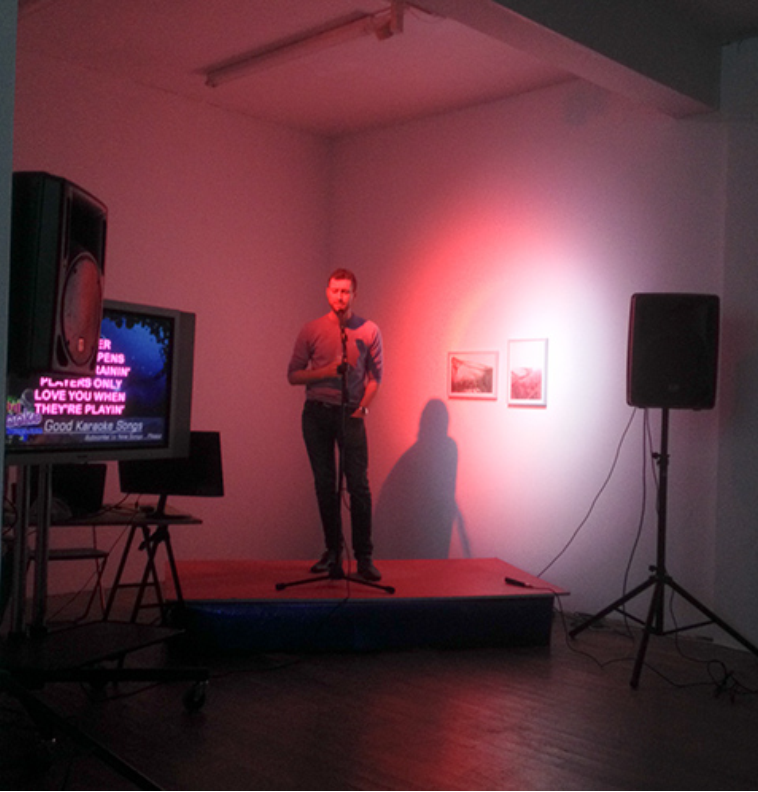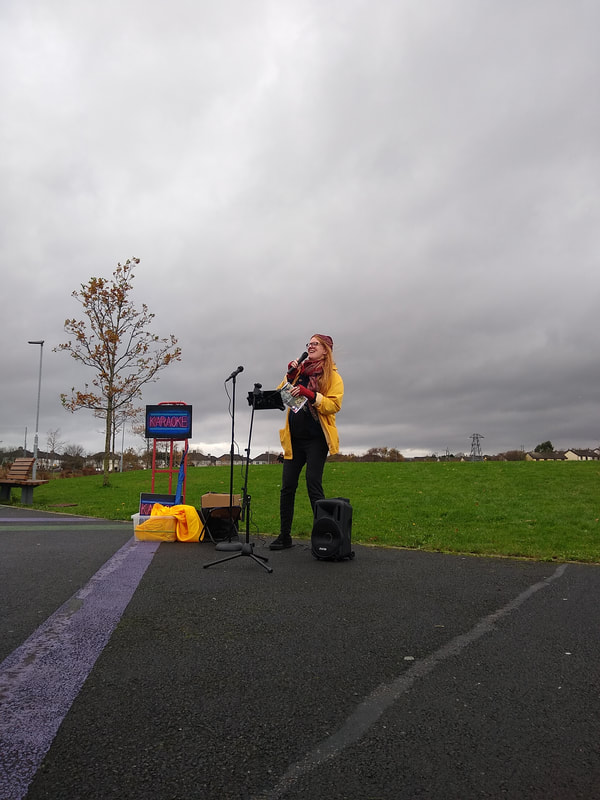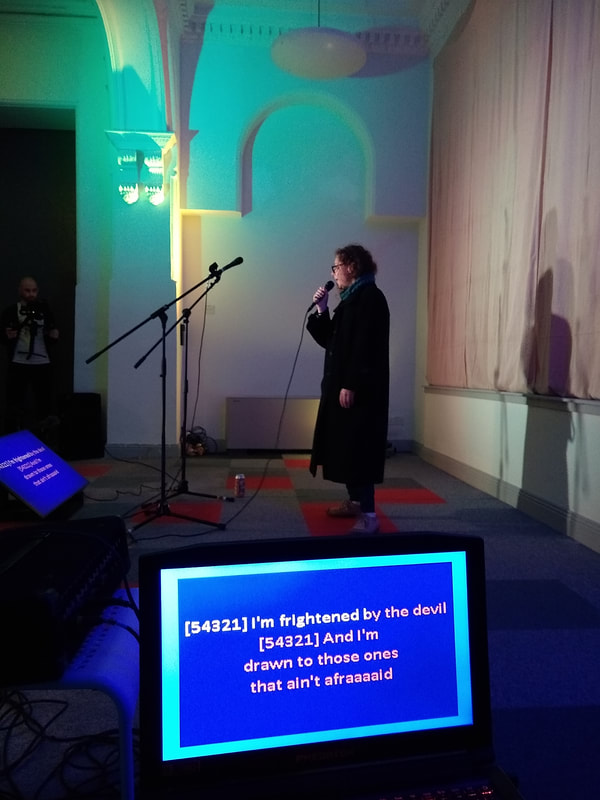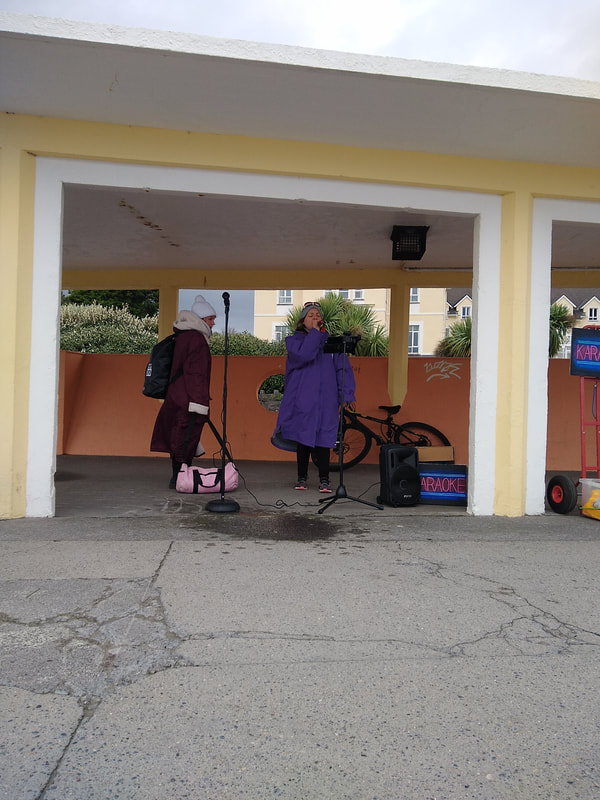Kim Gordon, of Sonic Youth, said you can never have a crush on art with the same intensity of the infatuation you have for a pop song.
In June 2019 I hosted a public karaoke event at Pallas Projects/Studios as part of my exhibition there at the time. There were screens, a microphone, mixer, and speakers. I had curated some themed selections of songs into playlists for people to choose from, or in many cases people just searched for their preferred song on Youtube (connected to the screens and speakers). Many people were nervous (but sang anyways). Some just watched. Some were consummate performers. There were solo performances, duets, and group singalongs.
For some, karaoke inspires a particular form of anxiety spanning multiple cultural concerns. Seen as an affront to the prized musical values of originality and authenticity, and shrouded in a context of booze and humiliation, it has been spurned as a crass activity reserved for hen nights, X Factor contestants and James Corden. On the other hand, karaoke is unique as an entertainment technology and a mode of performance in that it is necessarily incomplete without the participation of the singer. It is not content, but a way of doing, that foregrounds the process-oriented value of amateur performance. As Rob Drew describes it, karaoke’s promise rests in its affordance of a platform “to have a voice and be heard. To delight yourself and thereby delight others. To make a song your own and dispense it as a gift."1 A community emerges as it listens. It is this understanding of karaoke as a way of doing which interests me here.
This kind of facilitation of discursive encounters arguably places karaoke within the context of the relational and dialogical art work of the past 20 or so years, and similarly, I want to create spaces where we can practice different ways to communicate with one another. However, where other writers and artists have focused on the value of singing in and of itself, in this work I want to examine the value of listening as an integral aspect of karaoke as a “way of doing.”
Knowledge speaks, but wisdom listens.
In the West, we generally privelege “the assertive tradition of saying”. We are good at talking. Or at least, we talk a lot. But are our listening skills so well attuned? To more emotive or non verbal articulation? Philosopher Gemma Corradi Fiumara, has spoken about "listening as a primary creative practice."2 Art historian Grant Kester has drawn attention to listening as an active component of dialogic art practices. It is through listening and adjusting our listening habits to suit the speaker that we begin to develop ethical models for intersubjective experience. Listening as a vital part of a procedural knowledge. Perhaps this adjusting of our listening habits is analogous to the safety implied in the karaoke space, one in which participants may risk aesthetic exposure in front of the sympathetic ears of the audience.
More broadly speaking listening is a means by which we sense our relationship to the world. The sensory experience of listening announces the promise of being somewhere. Listening brings us together. It stitches together bodies that do not necessarily search for each other, and forcing them into proximity for a moment, or longer.3
Come Together
This idea of bringing bodies together and "publicness" is something that has been absent from many of our lives for the past year and is something I have been thinking about in relation to this work. The context of covid and "after-covid". Being with people. Being with friends. Being with strangers. I feel as though I am out of practice. As though I have forgetten how to be around people and talk and communicate with them. I have spoken to others who feel something similar. An awkwardness. There is usually a non-relation between karaoke and publicness. It is usually found in the dark bars and booths. I want to create public spaces where we can begin to tease out old and new ways of saying and listening to one another again.
More broadly today, public discourse is fraught with challenges, and globally there is a need for new means of expression. In our increasingly privatised cities, publicness as a sense of being-in-common-in-a-world is neither a simple matter of being outdoors in a common space nor the exclusive concern of explicitly political organization but rather may be initiated through more casual modes of encounter, like a party, a stroll, a gig, a match, or perhaps, a karaoke event.
1Rob Drew, Karaoke Nights: An Ethnographic Rhapsody (Lanham, MD: AltaMira Press, 2001), 7.
2 Gemma Corradi Fiumara, The Other Side of Language: A Philosophy of Listening (London: Routledge Press,1990), 11.
3 LaBelle, Brandon. “Acoustic Spatiality.” – Journal of Literature, Culture and Literary Translation 6(2) (2012). A
________________________________________________________________________________________________________________________________________________________
Dúirt Kim Gordon, as Sonic Youth, nach féidir leat titim i ngrá leis an ealaín riamh leis an déine chéanna san dúil atá agat d’amhrán pop.
Cad a déarfaidh mé leat nuair a fheiceann mé thú arís? Le bheith le daoine. Cairde agus strainséirí. Is dóigh liom go bhfuilim as cleachtadh. Go ndearna mé dearmad ar conas a bheith timpeall ar dhaoine agus labhairt leo.
Conas is féidir linn teagmháil a dhéanamh nuair nach féidir linn teagmháil a dhéanamh? Sroicheann an guth mar fhuaim sinn go díreach. Téann sé go fisiciúil tríd an gcanáil chluas, ag creathadh ar fud ár gcorp. Nóta guth ó dhuine atá gar dhuit. Liosta amhrán a rinne tú do dhuine.
Is ócáid poiblí é 'I Hear Voices' agus le haghaidh cómhrá agus cannadh. Déanann sé iarracht sféar poiblí coimhthithe a athbhunú, agus pobal a chothú. Ardán le haghaidh léiriú níos mothúchánach, gothaí, agus éisteacht ghníomhach.
Cuireann Karaoke tábhacht ar luach na feidhmíochta amaitéaraí. Geallann sé ardán dúinn chun“guth a bheith againn agus éisteacht a fháil. Le gliondar a bhaint as tú féin agus mar sin gliondar a thabhairt do dhaoine eile. Chun an t-amhrán a athchruthú duit féin agus é a ligean amach do dhaoine mar bhronntanas. "1 Tagann pobal le chéile agus iad ag éisteacht.
Is trí éisteacht agus oiriúnú ár nósanna éisteachta don chainteoir a thosaímid ag forbairt samhlacha eiticiúla d’eispéireas idirshubstainteach. Tá an éisteacht ionbhách seo cosúil leis an tsábháilteacht atá intuigthe san spás karaoke, áit ar féidir le daoine a bheith amaideach os comhair cluasa báúla. Ar bhonn níos leithne, fógraíonn éisteacht an gealltanas go bhfuilimid áit éigin. Tugann an éisteacht le chéile muid. Cuireann sé corpannaí le chéile nach raibh cuardach a dhéanamh ar a chéile, agus cuireann sé i le chéile iad ar feadh nóiméid nó níos faide.
Ar bhonn níos leithne inniu, tá dúshláin ag baint le dioscúrsa poiblí. Tá gá le modhanna nua cainte. I gcathracha atá ag éirí níos príobháidithe, ní ceist shimplí í an phoiblíocht a bheith amuigh faoin aer i spás coiteann ná ní amháin imní le haghaidh eagraíocht polaitíochta. Ach is féidir í a thionscnamh trí mhodhanna teagmhála níos neamhfhoirmiúla, cosúil le cóisir, spaisteoireacht, gig, cluiche, nó b’fhéidir, ócáid sna tithe tábhairne.
In June 2019 I hosted a public karaoke event at Pallas Projects/Studios as part of my exhibition there at the time. There were screens, a microphone, mixer, and speakers. I had curated some themed selections of songs into playlists for people to choose from, or in many cases people just searched for their preferred song on Youtube (connected to the screens and speakers). Many people were nervous (but sang anyways). Some just watched. Some were consummate performers. There were solo performances, duets, and group singalongs.
For some, karaoke inspires a particular form of anxiety spanning multiple cultural concerns. Seen as an affront to the prized musical values of originality and authenticity, and shrouded in a context of booze and humiliation, it has been spurned as a crass activity reserved for hen nights, X Factor contestants and James Corden. On the other hand, karaoke is unique as an entertainment technology and a mode of performance in that it is necessarily incomplete without the participation of the singer. It is not content, but a way of doing, that foregrounds the process-oriented value of amateur performance. As Rob Drew describes it, karaoke’s promise rests in its affordance of a platform “to have a voice and be heard. To delight yourself and thereby delight others. To make a song your own and dispense it as a gift."1 A community emerges as it listens. It is this understanding of karaoke as a way of doing which interests me here.
This kind of facilitation of discursive encounters arguably places karaoke within the context of the relational and dialogical art work of the past 20 or so years, and similarly, I want to create spaces where we can practice different ways to communicate with one another. However, where other writers and artists have focused on the value of singing in and of itself, in this work I want to examine the value of listening as an integral aspect of karaoke as a “way of doing.”
Knowledge speaks, but wisdom listens.
In the West, we generally privelege “the assertive tradition of saying”. We are good at talking. Or at least, we talk a lot. But are our listening skills so well attuned? To more emotive or non verbal articulation? Philosopher Gemma Corradi Fiumara, has spoken about "listening as a primary creative practice."2 Art historian Grant Kester has drawn attention to listening as an active component of dialogic art practices. It is through listening and adjusting our listening habits to suit the speaker that we begin to develop ethical models for intersubjective experience. Listening as a vital part of a procedural knowledge. Perhaps this adjusting of our listening habits is analogous to the safety implied in the karaoke space, one in which participants may risk aesthetic exposure in front of the sympathetic ears of the audience.
More broadly speaking listening is a means by which we sense our relationship to the world. The sensory experience of listening announces the promise of being somewhere. Listening brings us together. It stitches together bodies that do not necessarily search for each other, and forcing them into proximity for a moment, or longer.3
Come Together
This idea of bringing bodies together and "publicness" is something that has been absent from many of our lives for the past year and is something I have been thinking about in relation to this work. The context of covid and "after-covid". Being with people. Being with friends. Being with strangers. I feel as though I am out of practice. As though I have forgetten how to be around people and talk and communicate with them. I have spoken to others who feel something similar. An awkwardness. There is usually a non-relation between karaoke and publicness. It is usually found in the dark bars and booths. I want to create public spaces where we can begin to tease out old and new ways of saying and listening to one another again.
More broadly today, public discourse is fraught with challenges, and globally there is a need for new means of expression. In our increasingly privatised cities, publicness as a sense of being-in-common-in-a-world is neither a simple matter of being outdoors in a common space nor the exclusive concern of explicitly political organization but rather may be initiated through more casual modes of encounter, like a party, a stroll, a gig, a match, or perhaps, a karaoke event.
1Rob Drew, Karaoke Nights: An Ethnographic Rhapsody (Lanham, MD: AltaMira Press, 2001), 7.
2 Gemma Corradi Fiumara, The Other Side of Language: A Philosophy of Listening (London: Routledge Press,1990), 11.
3 LaBelle, Brandon. “Acoustic Spatiality.” – Journal of Literature, Culture and Literary Translation 6(2) (2012). A
________________________________________________________________________________________________________________________________________________________
Dúirt Kim Gordon, as Sonic Youth, nach féidir leat titim i ngrá leis an ealaín riamh leis an déine chéanna san dúil atá agat d’amhrán pop.
Cad a déarfaidh mé leat nuair a fheiceann mé thú arís? Le bheith le daoine. Cairde agus strainséirí. Is dóigh liom go bhfuilim as cleachtadh. Go ndearna mé dearmad ar conas a bheith timpeall ar dhaoine agus labhairt leo.
Conas is féidir linn teagmháil a dhéanamh nuair nach féidir linn teagmháil a dhéanamh? Sroicheann an guth mar fhuaim sinn go díreach. Téann sé go fisiciúil tríd an gcanáil chluas, ag creathadh ar fud ár gcorp. Nóta guth ó dhuine atá gar dhuit. Liosta amhrán a rinne tú do dhuine.
Is ócáid poiblí é 'I Hear Voices' agus le haghaidh cómhrá agus cannadh. Déanann sé iarracht sféar poiblí coimhthithe a athbhunú, agus pobal a chothú. Ardán le haghaidh léiriú níos mothúchánach, gothaí, agus éisteacht ghníomhach.
Cuireann Karaoke tábhacht ar luach na feidhmíochta amaitéaraí. Geallann sé ardán dúinn chun“guth a bheith againn agus éisteacht a fháil. Le gliondar a bhaint as tú féin agus mar sin gliondar a thabhairt do dhaoine eile. Chun an t-amhrán a athchruthú duit féin agus é a ligean amach do dhaoine mar bhronntanas. "1 Tagann pobal le chéile agus iad ag éisteacht.
Is trí éisteacht agus oiriúnú ár nósanna éisteachta don chainteoir a thosaímid ag forbairt samhlacha eiticiúla d’eispéireas idirshubstainteach. Tá an éisteacht ionbhách seo cosúil leis an tsábháilteacht atá intuigthe san spás karaoke, áit ar féidir le daoine a bheith amaideach os comhair cluasa báúla. Ar bhonn níos leithne, fógraíonn éisteacht an gealltanas go bhfuilimid áit éigin. Tugann an éisteacht le chéile muid. Cuireann sé corpannaí le chéile nach raibh cuardach a dhéanamh ar a chéile, agus cuireann sé i le chéile iad ar feadh nóiméid nó níos faide.
Ar bhonn níos leithne inniu, tá dúshláin ag baint le dioscúrsa poiblí. Tá gá le modhanna nua cainte. I gcathracha atá ag éirí níos príobháidithe, ní ceist shimplí í an phoiblíocht a bheith amuigh faoin aer i spás coiteann ná ní amháin imní le haghaidh eagraíocht polaitíochta. Ach is féidir í a thionscnamh trí mhodhanna teagmhála níos neamhfhoirmiúla, cosúil le cóisir, spaisteoireacht, gig, cluiche, nó b’fhéidir, ócáid sna tithe tábhairne.

